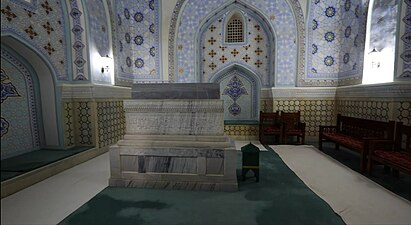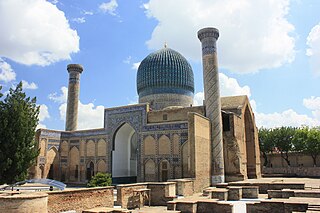
The Gūr-i Amīr or Guri Amir is a mausoleum of the Turco-Mongol conqueror Timur in Samarkand, Uzbekistan. It occupies an important place in the history of Central Asian architecture as the precursor for and had influence on later Mughal architecture tombs, including Gardens of Babur in Kabul, Humayun's Tomb in Delhi and the Taj Mahal in Agra, built by Timur's Indian descendants, Turco-Mongols that followed Indian culture with Central Asian influences. Mughals established the ruling Mughal dynasty of the Indian subcontinent. The mausoleum has been heavily restored over the course of its existence.

Shahrisabz is a district-level city in Qashqadaryo Region in southern Uzbekistan. The Economic Cooperation Organization (ECO) has selected Shakhrisabz as its tourism capital for 2024.

Qashqadaryo Region is one of the regions of Uzbekistan, located in the south-eastern part of the country in the basin of the river Qashqadaryo and on the western slopes of the Pamir-Alay mountains. It borders with Tajikistan, Turkmenistan, Samarqand Region, Bukhara Region and Surxondaryo Region. It covers an area of 28,570 km2. The population is estimated 3,408,345 (2022), with 57% living in rural areas. The regional capital is Qarshi.

Chashma-Ayub Mausoleum is located near the Samani Mausoleum, in Bukhara, Uzbekistan. Its name means Job's well, due to the legend in which Job (Ayub) visited this place and made a well by striking the ground with his staff. The water of this well is still pure and is considered healing. The current building was constructed during the reign of Timur and features a Khwarazm-style conical dome uncommon in Bukhara.

Dor-i-Tilavat - in the center of Shahrisabz, in the west of the Darussiodat complex, there is a complex consisting of ancient structures belonging to the Timurid dynasty - the tomb of Shamsuddin Kulol, Gumbazi Sayyidon, and the Blue Dome Mosque, built on the site of the old madrasa here.

The Hakim at-Termizi Mausoleum is a historical funerary monument located in the Sherobod district of Surxondaryo Region, Uzbekistan. It serves as a memorial to Islamic scholar Al-Hakim at-Termizi. The mausoleum was constructed on top of his grave.
The Pahlavon Mahmud complex, Pahlavon Mahmud mausoleum or Polvon ota mausoleum is a memorial monument in Khiva, Khorezm. The mausoleum complex has a total area of 50x30m, and was originally built in 1664 as a miraculous dome over the grave of Pahlavon Mahmud. Pahlavon Mahmud (1247-1326) was a local poet who emerged from humble craftsmen, and was also famous for his heroic strength as an unbeatable wrestler, and his ability to heal people. His tomb has been and is still considered a sacred place by representatives of Uzbeks, Turkmens, Karakalpaks and other peoples. This complex is also known in Khiva as “Hazrati Pahlavon Pir”.

The Termiziy Mausoleum is an architectural monument built between 11th and 12th centuries, located in Sherobod district of Surxondaryo Region, Uzbekistan. The mausoleum was built over the grave of the famous hadith scholar Abu Iso Muhammad Termiziy.
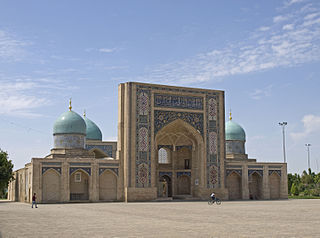
The Hazrati Imam complex is an architectural monument dating from the 16th to 20th centuries, located in the Olmazor district of Tashkent city, Uzbekistan. The complex consists of the Moʻyi Muborak madrasa, the Qaffol Shoshi mausoleum, the Baroqxon Madrasa, the Hazrati Imam mosque, the Tillashayx mosque, and the Imam al-Bukhari Islamic Institute. The ensemble was built near the grave of Hazrati Imam, the first imam-khatib of Tashkent, a scholar, one of the first Islamic preachers in Tashkent, a poet and an artist.

Qaffol Shoshi mausoleum is a mausoleum in Tashkent, Uzbekistan, built in honor of Imam Abu Bakr Muhammad ibn Ali ibn Ismail al-Kaffal ash-Shashi. The original tomb did not survive in its initial form. In its current state, the mausoleum was constructed in 1542 by the royal architect of that time, Gulyam Husayn. It is an asymmetrical domed portal mausoleum, known as a khanqah. Khanqahs were designed to provide pilgrims shelter in residential places called “khujrahs”. Mausoleum complexes often included a mosque and a kitchen. To the south of the main building in a small courtyard, there are later burial places (saganas).
The Mirijanda Mausoleum is a cultural heritage object located in Uzbekistan. The object was built in the 5th–6th centuries. The mausoleum is located in the Mardtepa village, Gʻuzor District, Kashkadarya region. According to the property rights, it is state property. It was included in the national register of intangible cultural heritage objects by the decree of the Cabinet of Ministers of the Republic of Uzbekistan on October 4, 2019 - taken under state protection.
The Hazrati Bashir Mausoleum is a cultural heritage object located in Uzbekistan. The object was built in the 18th century. Hazrati Bashir mausoleum is located in the Bashir village of Kitob district, Qashqadaryo region. According to the rights of immovable property, it is considered state property on the basis of the operational management right of the Qashqadaryo region cultural heritage administration.
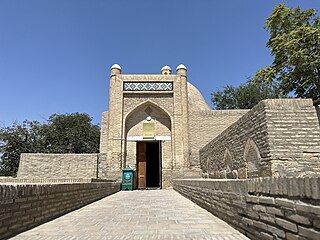
The Boboyi Poradoz Mausoleum is a monument of architecture in Bukhara, Uzbekistan. The mausoleum was built in the 19th century and is located behind the Salakhona gate. Today the mausoleum is located opposite the Ibn Sina Library of Bukhara. The mausoleum is included in the National List of Objects of Material Cultural Heritage of Uzbekistan of Republican Importance.

Turkan Ago Mausoleum, Shadi Mulk Aga, is a memorial monument in Samarkand (1372), Uzbekistan. It is part of the ensemble of Shah-i-Zinda. Turkan Ogo, the sister of Amir Temur, had the tomb built for her deceased daughter Shodimulk Ogo (1370-71). In 1383, Turkan Ogo herself was also buried next to her daughter. The mausoleum(8.65x9.85 m) is a single-chambered structure with a domed roof, and its external walls are plain. The front and interior sides are adorned with intricate mosaic tiles, silk curtains, and fine fabrics in turquoise color. The interior features inscriptions and ornaments, and the dome is covered with fine fabrics. The mausoleum is divided into 8 sections, each adorned with stars and intricate patterns. The surfaces of iwan and the area above the entrance bear the names of the master craftsmen from Samarkand, namely Shamsiddin, Badriddin, and Zayniddin, written in turquoise. The mausoleum was studied in 1954, and restoration work has been done since then. The mausoleum reflects the artistic achievements of the people in the 14th and 15th centuries in memorial and decorative arts.

The Sheikh Hovendi at-Tahur Complex is an architectural complex, centered around the Mausoleum of Sheikh Hovendi at-Tahur (Sheikhantaur). It is one of the most important architectural monuments of Tashkent, Uzbekistan. It is located in the center of Tashkent in the quadrangle formed by the streets of Alisher Navoi, Shaykhantohur and Abdulla Kadiri.

Termizi Memorial Complex, Hakim Termezi Mausoleum, is a historical site in Termez, Uzbekistan. Al-Hakim al-Termezi Mausoleum, considered sacred for Muslims, is situated in the ancient part of Termez. It houses the tomb of Abu Abdullah Muhammad Hakim Termezi, a prominent Islamic scholar, author of various philosophical and religious works, and the founder of a group of dervishes. The complex is associated with Abu Abdullah Muhammad Hakim Termezi. This mausoleum houses the grave of Termezi. The Termezi Memorial Complex has been reconstructed several times throughout the centuries. Today, this complex is considered one of the primary pilgrimage sites for visitors and guests of the province.

Qarshi Bridge is an ancient brick bridge built over the Qashqadaryo River flowing through the territory of Qarshi city, connecting the two parts of the city. It is considered one of the symbols of the city of Qarshi. The construction of this bridge, which has reached so far, was carried out in the second half of the 16th century. Qarshi bridge is the largest bridge built over Qashqadaryo.

Kuk Gumbaz Mosque is an architectural monument in the city of Qarshi, Qashqadaryo Region, Uzbekistan. By the decision of the President of the Republic of Uzbekistan on 19 December 2018, the Khojash Mahram Madrasah was included in the national list of real estate objects of tangible cultural heritage and received state protection.
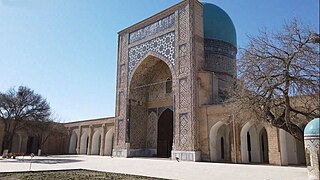
Kuk Gumbaz Mosque is an architectural monument located in Shahrisabz, Qashqadaryo Region, Uzbekistan. The mosque was built between 1434 and 1435 by Ulug Beg Mirzo for his father Shah Rukh Mirzo. Historical inscriptions with the names of the Timurids and the time of construction have been preserved in the porch of the mosque.

Gumbazi Sayidon is an architectural monument located in Shahrisabz. This mausoleum is also popularly known as Sayidlar Gumbaz, Ulugbek's mausoleum, Gumbazi Seyidon.




